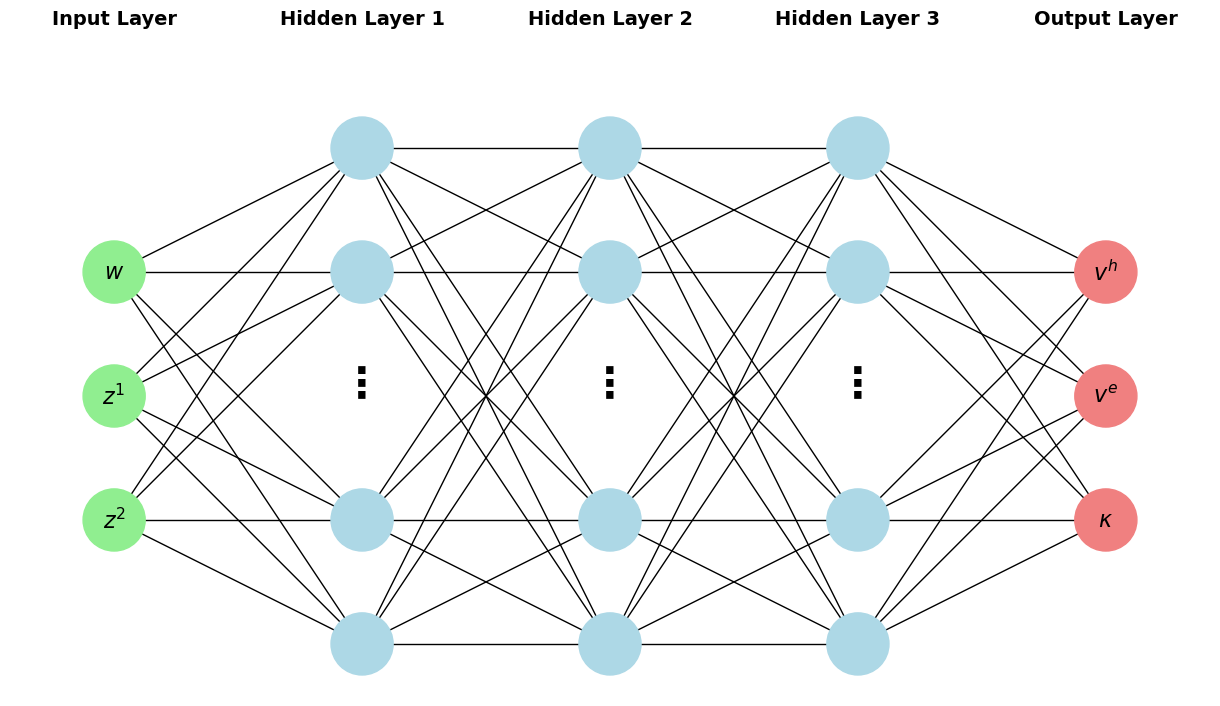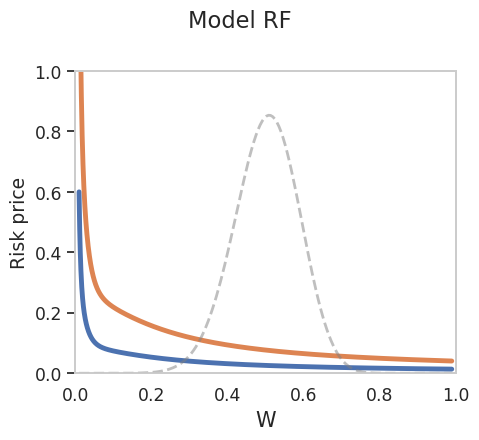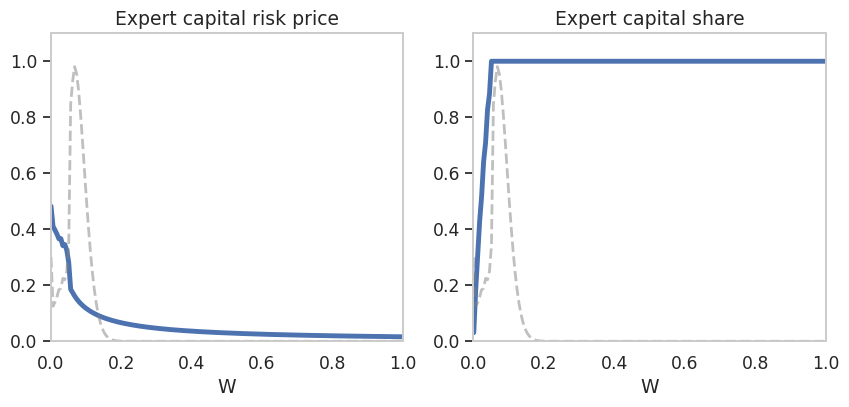4 Heterogeneous Agents#
This Python notebook covers the environment in section 5. We need to solve the following:
Expert’s HJB equation
Household’s HJB equation
Optimal expert capital share
Optimal expert equity retention
Where:
Since \(\chi\) can be solved algebraically, we solve (1) to (3).
4.1 Solution Overview#
4.1.1 Model Architecture#
We modify the DeepGalerkinMethod code from the companion code to Correia et. al 2018. We construct a feedforward, fully-connected neural network to approximate \(v^e\), \(v^h\) and \(\kappa\) as functions of the states.

Fig. 2 Neural network architecture used in this computation. Note that in the paper, layer_width=16.#
We employ the following hyperparameters:
Input |
Description |
Parameter used in paper |
|---|---|---|
|
Number of layers |
2 |
|
Number of neurons in each layer |
16 |
|
Dimension of input into first layer |
3 (This should be the same as the number of states) |
|
Activation function for all layers except the last |
tanh |
|
Activation function for final layer |
Identity function for first two dimensions; sigmoid for third dimension. This is so that… |
|
Seed for weight and bias initialization |
256 |
We use a Glorot normal initializer to initialize weights and a Glorot uniform initializer to initialize the biases.
4.1.2 Training#
The training set is constructed by drawing uniformly from the three-dimensional cube bounded by [wMin,zMin,vMin] and [wMax,zMax,vMax]. The loss function is given by the mean squared error of \(L\), where:
Where \(p\) is a penalization parameter. We compute gradients using tf.GradientTape and use an L-BFGS-B solver. For the settings used in the paper, there are 659 trainable variables: 3x16 weights and 16 bias terms for the initial layer; 16x16 weights and 16 bias terms for each hidden layer; and 16x3 weights and 3 bias terms for the final layer. The full list of parameters for the training stage are:
Input |
Description |
Parameter used in paper |
|---|---|---|
|
Determines the |
10 |
|
Number of epochs, i.e. the number of complete passes through the training set |
5 |
|
Penalty for violating \(\kappa\) constraint |
10000 |
|
Seed for drawing uniform samples |
256 (same as seed for initialization) |
|
Maximum number of L-BFGS-B iterations (number of times parameters are updated) per epoch |
100 |
|
Maximum number of function evaluations per epoch |
100 |
|
The maximum number of variable metric corrections used to define the limited memory matrix used to compute the Hessian per epoch |
100 |
|
Maximum number of line search steps per iteration used to find the optimal step-size |
100 |
|
Iteration will stop when \(\max|proj(g_i)| \leq\) |
Machine epsilon for float64 (~\(2^{-16}\)) |
|
Iteration will stop when \(\frac{L^k - L^{k+1}}{\max{|L^k|,|L^{k+1}|,1}} \leq\) |
Machine epsilon for float64 (~\(2^{-16}\)) |
|
Iteration will stop when, after fully completing an epoch, \(L\) is less than |
\(10^{-5}\) |
4.1.3 Model Parameters#
We also need to set model parameters. These will vary depending on the environment chosen from Section 5.1. By default, the following parameters are allowed as inputs to main_BFGS:
Input |
Description |
Parameter used in paper |
|---|---|---|
|
Skin-in-the-game constraint |
\(\underline{\chi}\) |
|
Expert and household uncertainty aversion |
\(\gamma_e, \gamma_h\) |
|
Expert and household productivity |
\(\alpha_e, \alpha_h\) |
|
Expert and household discount rate |
\(\delta_e, \delta_h\) |
|
Expert and household inverse of IES |
\(\rho_e, \rho_h\) |
|
Birth/death rate |
\(\lambda_d\) |
|
Fraction of newborns which are experts |
\(\nu\) |
|
Mean of \(Z_2\) |
\(\mu_2\) |
|
Normalization for variances; these are multiplied by the covariance matrix specified in |
|
|
Bounds for training set for \(W\); the corresponding bounds for \(Z_1\) and \(Z_2\) can be edited in |
|
|
Number of gridpoints for each state variable; this does not have any effect on the solution but will determine the evaluation of variables of interest using the solution at a later step |
|
|
Determines whether the shock exposure matrix is “upper_triangular” or “lower_triangular” |
In addition, the following parameters can be edited in the utils_para file. They do not vary across the models explored in the paper, but the user may wish to explore their own variations.
Input |
Description |
Notation used in paper |
Default used in paper |
|---|---|---|---|
|
Mean of \(Z^1\) |
0.0 |
|
|
Persistence of $Z^1 |
\(\beta_1\) |
0.056 |
|
Persistence of \(Z^2\) |
\(\beta_2\) |
0.194 |
|
\(\eta_k\) |
\(\alpha\) |
0.04 |
|
Adjustment cost |
\(\phi\) |
8.0 |
|
\(i,j\) entry in shock exposure matrix |
See Table 1 in paper |
|
|
Governs grid size for \(Z^1\) and \(Z^2\) (number of standard deviations from the mean) |
5 |
|
|
Grid boundaries for \(Z^1\) |
\(\mu_1 \pm SD\cdot Var(Z_1|Z_2=\mu_2)\) where \(SD=\) |
|
|
Grid boundaries for \(Z^2\) |
|
4.2 Quick Start#
We can build and train the neural network as follows. First, we import libraries:
import json
import numpy as np
import tensorflow as tf
import time
import os
os.chdir("src/4")
from main_BFGS import main
from utils_para import setModelParameters
from utils_training import training_step_BFGS
from utils_DGM import DGMNet
os.chdir("../..")
import warnings
warnings.filterwarnings("ignore")
tf.get_logger().setLevel('ERROR')
tf.config.set_visible_devices([], 'GPU')
Next, we set the model parameters and hyperparameters. In the following example, we have used a variant of Model RF.
chiUnderline = 1.0
gamma_e = 4.0
a_e=0.0922
a_h=0.0
gamma_h=4.0
delta_e=0.0115
delta_h=0.01
lambda_d=0.0
rho_e=1.0
rho_h=1.0
nu=0.1
V_bar=0.0000063030303030303026
sigma_K_norm=3.1707442821755683
sigma_Z_norm=19.835431735873996
sigma_V_norm=0.0010882177801089308
wMin=0.01
wMax=0.99
nWealth=180
nZ=30
nV=30
seed_=(256)
n_layers_=(2)
units_=(16)
points_size_=(10)
iter_num_=(5)
penalization=10000
BFGSmaxiter=100
BFGSmaxfun=100
action_name = 'test'
seed=256
n_layers=2
units=16
points_size=10
iter_num=5
penalization=10000
BFGS_maxiter=100
BFGS_maxfun=100
shock_expo = 'upper_triangular'
Next, we run the main solution, which trains the neural network. Under the parameterization above, this will take around 1 minute.
main(action_name, nWealth, nZ, nV, V_bar, sigma_K_norm, sigma_Z_norm, sigma_V_norm, wMin, wMax, chiUnderline, a_e, a_h, gamma_e, gamma_h, rho_e, rho_h, delta_e, delta_h, lambda_d, nu, shock_expo, n_layers, points_size, iter_num, units, seed, penalization, BFGS_maxiter, BFGS_maxfun)
Now that we have a solution, we can compute variables of interest, which can subsequently be used to compute shock elasticities. By default, main_variable computes the following variables. Unless specified otherwise, the variables are evaluated on an array with dimension [nWealth,nZ,nV].
Output |
Description |
Notation used in paper |
|---|---|---|
|
The values of \(W\), \(Z_1\) and \(Z_2\) on the state-space grid |
|
|
Expert and household value functions |
\(V_e\), \(V_h\) |
|
Log expert and household value functions |
\(\hat{V}_e\), \(\hat{V}_h\) |
|
Expert equity retention |
\(\chi\) |
|
Expert capital share |
\(\kappa\) |
|
Risk-free rate |
\(r\) |
|
Price of capital |
\(Q\) |
|
State volatilities |
\(Z^2 \sigma_w\),\(Z^2 \sigma_1\), \(Z^2 \sigma_2\) |
|
State drifts |
\(\mu_w\),\(\mu_1\),\(\mu_2\) |
|
Log capital drift |
\(\mu_{k}\) |
|
Log capital diffusin |
\(\sigma_{k}\) |
|
Capital price drift |
\(\mu_q\) |
|
Capital price diffusion |
\(\sigma_q\) |
|
Capital return volatility |
\(\sigma_r\) |
|
Expert and household risk premium wedge |
\(\Delta^e\),\(\Delta^h\) |
|
Expert and household equity risk price |
\(\pi_e\),\(\pi_h\) |
|
\(\frac{\chi \kappa}{W}\), \(\frac{1- \kappa}{W}\) |
|
|
RHS of HJB equations and \(\kappa\) constraint evaluated on the state space grid |
\(L^e\), \(L^h\), \(L^{\kappa}\) |
|
Loss function (scalar) |
|
|
Stationary density |
|
|
First and second derivatives of expert and household value function with respect to each of the states; separate objects for each state are also included |
|
|
Log SDF drifts for expert and household |
\(-r_t S_t^e\), \(-r_t S_t^h\) |
|
Log SDF diffusions for expert and household |
\(-S_t^e \pi_t^e\), \(-S_t^h \pi_t^h\) |
|
Log consumption drifts for expert and household |
\(\hat{\mu}_c^e\), \(\hat{\mu}_c^h\) |
|
Log consumption diffusions for expert and household |
\(\sigma_c^e\), \(\sigma_c^h\) |
|
Log aggregate consumption drift |
\(\hat{\mu}_c\) |
|
Log aggregate consumption diffusion |
\(\sigma_c\) |
Given that a solution has been saved under the same parameters, the following code outputs the variables listed above. In addition, the marginal_quantile_func_factory function is called to save the above outputs evaluated at desired quantiles (e.g. \(Z^2\) at median) for ease of plotting.
os.chdir('src/4')
from main_variable import main_var
os.chdir('../..')
main_var(action_name, nWealth, nZ, nV, V_bar, sigma_K_norm, sigma_Z_norm, sigma_V_norm, wMin, wMax, chiUnderline, a_e, a_h, gamma_e, gamma_h, rho_e, rho_h, delta_e, delta_h, lambda_d, nu, shock_expo, n_layers, units, points_size, iter_num, seed, penalization, BFGS_maxiter, BFGS_maxfun)
2024-09-03 01:55:37.533890: I tensorflow/core/platform/cpu_feature_guard.cc:193] This TensorFlow binary is optimized with oneAPI Deep Neural Network Library (oneDNN) to use the following CPU instructions in performance-critical operations: AVX2 AVX512F AVX512_VNNI FMA
To enable them in other operations, rebuild TensorFlow with the appropriate compiler flags.
4.3 Plotting#
We can now plot the results.
import os
import numpy as np
os.chdir('src/4')
from plot import return_NN_solution
os.chdir('../..')
import matplotlib.pyplot as plt
import seaborn as sns
sns.set(style="whitegrid", font_scale=1.13, rc={"lines.linewidth": 3.5})
plt.rcParams['axes.formatter.useoffset'] = True
First we load in the results using the same parameters as before.
results = return_NN_solution(shock_expo=shock_expo, seed=seed, chiUnderline=chiUnderline, a_e=a_e, a_h=a_h, gamma_e=gamma_e, gamma_h=gamma_h, psi_e=rho_e, psi_h=rho_h, delta_e=delta_e, delta_h=delta_h, lambda_d=lambda_d, nu=nu, n_layers=n_layers, units=units, iter_num=iter_num, points_size=points_size, penalization=penalization, action_name=action_name)
We provide an example plot below. Notice that we use results['eva_V_10'] and results['eva_V_90'] to extract the variables of interest evaluated at \(Z^1=0\) and \(Z^2\) at its 10th and 90th percentiles, respectively.
fig, ax = plt.subplots(1,1, figsize=(5,4.5))
W_dense = np.unique(results['eva_V_50']['W'])
W_sparse = np.unique(results['W'].values)
sns.lineplot(x = W_dense, y = results['eva_V_10']['PiE_NN'][:,0], ax = ax)
sns.lineplot(x = W_dense, y = results['eva_V_90']['PiE_NN'][:,0], ax = ax)
ax2 = ax.twinx()
sns.lineplot(x = W_sparse, y = results['dentW'].values, ax = ax2, ls='--', color='grey',lw=2.0, alpha=0.5)
ax2.grid(False)
ax2.set_yticks([])
ax2.set_ylim([0,0.03])
ax.set_xlim(0,1.0)
ax.grid(False)
ax.set_ylim([0.0,1.0])
ax.set_xlabel('W', fontsize=15)
ax.set_ylabel('Risk price')
plt.suptitle("Model RF")
plt.tight_layout()

4.4 Finite Difference Method#
We employ a finite differences method from mfrSuite to solve the two-dimensional Model IP from Section 5, which we cover briefly here.
import mfr.modelSoln as m
import numpy as np
import argparse
import os
import sys
import warnings
warnings.filterwarnings("ignore")
os.chdir('src/5')
from main_solve import main_fdm
from main_evaluate import interpolate
os.chdir('../..')
The model inputs are identical to the neural network solution above, except that: we abstract away from \(Z^2\); we have to set \(dt\), the false-transient time-step; and some inputs have been moved inside the main_solve.py script.
chiUnderline = 1.0
a_e=0.0922
a_h=0.085
gamma_e = 2.0
gamma_h= 2.0
delta_e=0.03
delta_h=0.01
lambda_d=0.0
rho_e=1.0
rho_h=1.0
nu=0.1
dt = 0.1
nWealth=180
nZ=30
shock_expo = 'upper_triangular'
action_name = 'test'
main_fdm(nW=nWealth, nZ=nZ, dt=dt, a_e=a_e, a_h=a_h, rho_e=rho_e, rho_h=rho_h, gamma_e=gamma_e, gamma_h=gamma_h, chiUnderline=chiUnderline, action_name=action_name, shock_expo=shock_expo, delta_e=delta_e, delta_h=delta_h, lambda_d=lambda_d, nu=nu)
Show code cell output
Program converged. Took 8089 iterations and 199.59 seconds. 2.49% of the time was spent on dealing with the linear systems.
Parameter Value
nu_newborn 0.1
lambda_d 0.0
lambda_Z 0.056
lambda_V 0.0
lambda_Vtilde 0.0
Z_bar 0.0
V_bar 1.0
Vtilde_bar 0.0
sigma_K_norm 0.008696916904073742
sigma_Z_norm 0.049798518005773194
sigma_V_norm 0.0
sigma_Vtilde_norm 0.0
nWealth 180
nZ 30
nV 0
nVtilde 0
nDims 2
delta_e 0.03
delta_h 0.01
a_e 0.0922
a_h 0.085
rho_e 1.0
rho_h 1.0
phi 8.0
gamma_e 2.0
gamma_h 2.0
equityIss 2
hhCap 1
chiUnderline 1.0
method 2
dt 0.1
dtInner 0.1
tol 1e-05
innerTol 1e-05
maxIters 500000
maxItersInner 500000
iparm_2 28
iparm_3 0
iparm_28 0
iparm_31 0
numSds 5
wMin 0.001
wMax 0.999
logW -1
folderName output/test/upper_triangular/dt_0.1/nW_180_nZ_30/chiUnderline_1.000/a_e_0.092_a_h_0.085/gamma_e_2.000_gamma_h_2.000/rho_e_1.000_rho_h_1.000/delta_e_0.030_delta_h_0.010/lambda_d_0.000_nu_0.100
overwrite Yes
verbatim -1
exportFreq 1000000
cov11 0.9153150324227657
cov12 0.4027386142660167
cov21 0.0
cov22 1.0
Exporting solution information: time used, convergence error, etc.
Exporting state variables.
==========================================
Exporting numerical results.
==========================================
(1): Exporting risk prices and interest rate: q, piH, piE, deltaE, deltaH, r, I.
------------------------------------------------
(2) Exporting drifts: muQ, muX, muK, muRe, muRh.
------------------------------------------------
(3) Exporting vols: sigmaQ, sigmaR, sigmaK.
------------------------------------------------
(4) Exporting value and policy functions: XiE, XiH, cHatE, cHatH, kappa, chi, betaE, betaH.
------------------------------------------------
(5) Exporting derivs: first, second, and cross derivs of XiE and XiH.
------------------------------------------------
(6) Exporting the rest: experts' leverage, sigmaC, sigmaCe, sigmaCh, sigmaSe, sigmaSh, simgaLogY, muC, muCe, muCh, muY, muSe, muSh.
------------------------------------------------
Exporting matrices' information
==========================================
(1) Exporting matrix coefficients
------------------------------------------------
(2) Exporting matrices and RHSs.
------------------------------------------------
Before we can plot any variables of interest, we need to interpolate on our state space grid. Here we interpolate risk prices linearly using scipy.interpolate.griddata.
interpolate(nW=nWealth, nZ=nZ, dt=dt, a_e=a_e, a_h=a_h, rho_e=rho_e, rho_h=rho_h, gamma_e=gamma_e, gamma_h=gamma_h, chiUnderline=chiUnderline, action_name=action_name, shock_expo=shock_expo, delta_e=delta_e, delta_h=delta_h, lambda_d=lambda_d, nu=nu)
Show code cell output
interpolating PiE_final_capital
interpolating kappa_final
Now we can load and plot our results:
import pandas as pd
import pickle
np.set_printoptions(suppress=True, linewidth=200)
import matplotlib.pyplot as plt
import seaborn as sns
sns.set(style="whitegrid", font_scale=1.13, rc={"lines.linewidth": 3.5})
plt.rcParams['axes.formatter.useoffset'] = True
os.chdir("src/5")
from plot import return_fdm_solution
os.chdir("../..")
fdm_result = return_fdm_solution(shock_expo=shock_expo, dt=dt, nW=nWealth, chiUnderline=chiUnderline, a_e=a_e, a_h=a_h, gamma_e=gamma_e, gamma_h=gamma_h, rho_e=rho_e, rho_h=rho_h, delta_e=delta_e, delta_h=delta_h, lambda_d=lambda_d, nu=nu, action_name=action_name, nZ=nZ)
Here we plot the expert capital risk price and capital share as they vary with \(W\).
fig, axes = plt.subplots(1,2, figsize=(10,4))
W = fdm_result['W']['W'].unique()
sns.lineplot(x = W, y = fdm_result['PiE_final_capital'], ax = axes[0])
ax2 = axes[0].twinx()
sns.lineplot(x = W, y = fdm_result['dents'].values, ax = ax2, ls='--', color='grey',lw=2.0, alpha=0.5)
ax2.grid(False)
ax2.set_yticks([])
ax2.set_yticklabels([])
axes[0].set_ylim(0,1.1)
axes[0].set_xlim(0,1.0)
ax2.set_ylim([0,0.1])
axes[0].title.set_text("Expert capital risk price")
axes[0].set_xlabel('W')
sns.lineplot(x = W, y = fdm_result['kappa_final'], ax = axes[1])
ax2 = axes[1].twinx()
sns.lineplot(x = W, y = fdm_result['dents'].values, ax = ax2, ls='--', color='grey',lw=2.0, alpha=0.5)
ax2.grid(False)
ax2.set_yticks([])
ax2.set_yticklabels([])
axes[1].set_ylim(0,1.1)
axes[1].set_xlim(0,1.0)
ax2.set_ylim([0,0.1])
axes[1].title.set_text("Expert capital share")
axes[1].set_xlabel('W')
axes[0].grid(False)
axes[1].grid(False)
